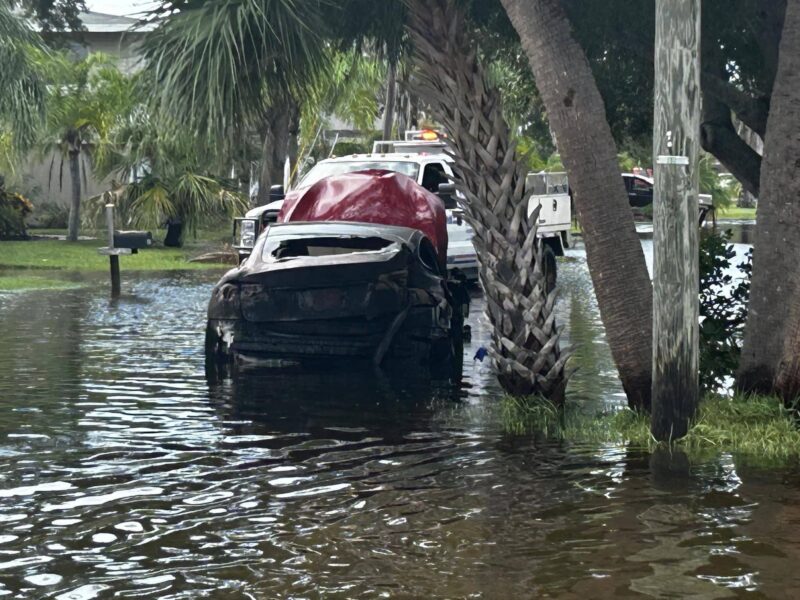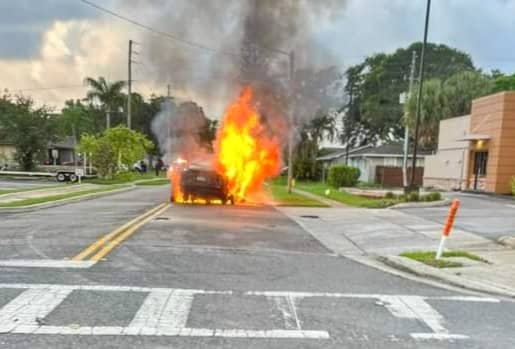Thrive
Electric vehicles catch fire in Idalia’s aftermath

As first responders, businesses and homeowners assess the damage caused by Hurricane Idalia’s storm surge, local officials have warned of a new safety risk – electric vehicle fires.
At least two Tesla cars seemed to spontaneously combust after encountering saltwater flooding. The first incident occurred in Idalia’s immediate aftermath.
Palm Harbor Fire Rescue responded to a Tesla that caught fire Wednesday, Aug. 30, in Dunedin. The agency attributed the blaze to a hazardous mix of storm surge and lithium-ion batteries.
“If you have an electric vehicle, and it flooded with saltwater, please do not keep it in your garage or right next to your home,” said Cathie Perkins, Pinellas County emergency management director, in a press conference Thursday. “It is susceptible to spontaneous combustion.”
Later that day, the Pinellas Park Fire Department responded to another Tesla fire. Deputy Chief Rob Angell told the Catalyst that the car flooded along the beach, and the owner wisely called a tow truck instead of attempting to drive it out of the area.
However, the owner and tow truck driver noticed the car smoking and pulled to the side of the road. Flames rapidly engulfed the electric vehicle (EV), and fire crews struggled to extinguish the blaze.
“It is somewhere in the neighborhood of 150 gallons (of water) a minute for 45 minutes, is the minimum,” Angell said. “Eventually, it will burn itself out.”
However, he noted that the lithium-ion batteries still measured 200 degrees on thermal imaging cameras. Fire personnel followed the tow truck in case the car reignited.

Another Tesla became engulfed in flames as a tow truck transported it through Pinellas Park. Photo: Facebook.
As of Friday afternoon, Angell said he remains unaware of any additional EV fires caused by local saltwater flooding. Recent history suggests the problem could have been worse.
The U.S. Fire Administration (USFA) recorded 12 EV fires in Collier and Lee Counties following Hurricane Ian in September 2022. One was so intense that it burned down two houses.
The USFA states that salt within the battery or its components can form “conductive bridges” that lead to short-circuiting and extreme heat. It adds that ignition can occur in days to weeks.
Tesla is aware of the risks. Its website recommends moving any submerged car at least 50 feet away from all structures or combustible materials to prevent vehicle fires from spreading.
“Tesla wants to ensure you have the information you need should there be a risk of vehicle submersion …,” the company states. “If you notice fire, smoke, audible popping/hissing or heating coming from your vehicle, step away and immediately contact your first responders.”
According to the U.S. Department of Energy, Florida has the second-highest number of registered EVs (168,000) in the nation. However, the problem extends far beyond automobiles.
Palm Harbor Fire Rescue (PHFR) officials noted that saltwater exposure can cause any lithium-ion batteries to combust. That includes the increasing number of electric golf carts and scooters seen on city streets.
“Don’t drive these through water,” the agency said in a social media post. “PHFR crews have seen numerous residents out in golf carts and children on scooters riding on the water.”
Angell now hopes to become better prepared for the next storm. He wants local fire officials to compare notes on mitigating EV fires.
“We’re actually trying to compile an SOP (standard operating procedure) on what to do and how to treat them,” Angell added. “There’s some conflicting stories on how to extinguish them or what to do when they’re on fire.”
That includes whether to let the vehicle burn or continuously spray water to cool the batteries. Angell also stressed the importance of ensuring surrounding buildings, people and first responders remain safe from dangerous chemicals.
His department’s hazardous materials team responded to Thursday’s fire to test the water runoff. Angell said all tests came back negative, “which was nice.”
“We have our training division, and we’re doing all of our homework to make sure we’re taking the safest and most effective precautions when it comes to EV cars,” he said. “It’s all so new …”








John Donovan
September 1, 2023at3:38 pm
Ruh ro. 21 similar fires last year with Ian.